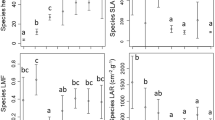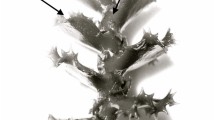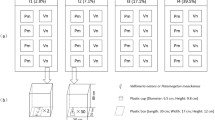Abstract
Submerged macrophytes, important primary producers in shallow lakes, play a crucial role in maintaining ecosystem structure and function. By altering a series of environmental factors, especially light intensity, water depth has great influences on growth of submerged macrophytes. Here, by hanging pots statically at water depths of 40, 60, 80, 100, 120, 140, 160, 180, 200, and 220 cm, respectively, we investigated effects of water depths on morphological plasticity and physiological traits of Potamogeton crispus. At 40 and 60 cm water depths versus other water depths, P. crispus showed lower plant height, larger stem diameter, thicker leaves, and smaller leaf area, leaf length, and specific leaf area. With water depth increasing, the plant height, leaf area, and leaf length gradually increased until 160 cm water depth, while the stem diameter and leaf thickness gradually decreased until 200 cm water depth. In comparison, the plant height, leaf length, and leaf number significantly decreased when the water depth further increased to 180–220 cm. The leaves contained lower concentrations of superoxide dismutase and peroxidase at 100–160 cm water depth, and lower catalase concentrations at 40–140 cm water depth, especially at 80–100 cm. In shallow waters, the concentration of chlorophyll a and b in leaves were both lower, while the ratio of chlorophyll a to b was relatively higher. As the water depth of 40–220 cm, the chlorophyll a and b concentrations increased significantly with increasing water depth, while their ratio gradually decreased. The present study provides new insights into the adaptation strategies of submerged macrophytes to the variation in water levels, and our findings are beneficial for ecosystem construction and management.




Similar content being viewed by others

Availability of data and materials
The datasets used and/or analyzed during the current study are available from the corresponding author on reasonable request.
References
Anderson JM, Aro EM (1994) Grana stacking and protection of photosystem II in thylakoid membranes of higher plant leaves under sustained high irradiance: an hypothesis. Photosynth Res 41:315–326
Barber J (1995) Molecular basis of the vulnerability of photosystem II to damage by light. Funct Plant Biol 22:201–208
Bezbaruah AN, Zhang TC (2005) Quantification of oxygen release by bulrush (Scirpus validus) roots in a constructed treatment wetland. Biotechnol bioeng 89:308–318
Blindow I, Hargeby A, Hilt S (2014) Facilitation of clear-water conditions in shallow lakes by macrophytes: differences between charophyte and angiosperm dominance. Hydrobiologia 737:99–110
Cao Y, Wu HY, Zhang SJ, Guo ZC, Wang GX (2016) Effects of water depth on the seedling morphology and chlorophyll fluorescence of Vallisneria natans. J Freshwater Ecol 31:463–475
Cao Y, Luo SS, Chen BX (2018) Effects of light intensity on growth and antioxidant enzyme activity of Potamogeton crispus. Acta Hydrobiol Sinica:846–853 (in Chinese)
Chen J, Cao T, Zhang X, Xi Y, Ni L, Jeppesen E (2016) Differential photosynthetic and morphological adaptations to low light affect depth distribution of two submersed macrophytes in lakes. Sci Rep 6:1–9
Chen J, Ren W, Chou Q, Su H, Ni L, Zhang M, Liu Z, Xie P (2020) Alterations in biomass allocation indicate the adaptation of submersed macrophytes to low-light stress. Ecol Indic 113:106235
Clarke JE, Johnson GN (2001) In vivo temperature dependence of cyclic and pseudocyclic electron transport in barley. Planta 212:808–816
Foyer CH, Noctor G (1999) Leaves in the dark see the light. Science 284:599–601
Fu H, Yuan G, Cao T, Ni L, Zhang M, Wang S (2012) An alternative mechanism for shade adaptation: implication of allometric responses of three submersed macrophytes to water depth. Ecol Res 27:1087–1094
Fu H, Zhong J, Yuan G, Xie P, Guo L, Zhang X, Cao T (2014) Trait-based community assembly of aquatic macrophytes along a water depth gradient in a freshwater lake. Freshwater Biol 59:2462–2471
Fu H, Yuan G, Lou Q, Dai T, Xu J, Cao T, Ni L, Zhong J, Fang S (2018) Functional traits mediated cascading effects of water depth and light availability on temporal stability of a macrophyte species. Ecol Indic 89:168–174
Fu H, Yuan G, Jeppesen E (2020) Trait-based community assembly of submersed macrophytes subjected to nutrient enrichment in freshwater lakes: do traits at the individual level matter? Ecol Indic 110:105895
Gao J, Xiong Z, Zhang J, Zhang W, Mba FO (2009) Phosphorus removal from water of eutrophic Lake Donghu by five submerged macrophytes. Desalination 242:193–204
Grime JP (1977) Evidence for the existence of three primary strategies in plants and its relevance to ecological and evolutionary theory. Am Nat 111:1169–1194
Gu YF, Wang J, Wang J (2017) Morphological response and growth strategy of the submerged macrophyte Vallisneria natans under different water depths. J Lake Sci 29:654–661 (in Chinese)
Hao B, Roejkjaer AF, Wu H, Cao Y, Jeppesen E, Li W (2018) Responses of primary producers in shallow lakes to elevated temperature: a mesocosm experiment during the growing season of Potamogeton crispus. Aquat Sci 80:34
He W, Wang GX, Yang WB (2009) Growth response of Potamogeton crispus to water depth gradient. Chinese J Ecol 28:1224–1228 (in Chinese)
He L, Zhu T, Wu Y, Li W, Zhang H, Zhang X, Hilt S (2019) Littoral slope, water depth and alternative response strategies to light attenuation shape the distribution of submerged macrophytes in a mesotrophic lake. Front Plant Sci 10:169
Hu XF, Shen MN, Xu SY (2002) Determination of total nitrogen in water by alkaline potassium persulfate oxidation-UV spectrophotometric method. Environ Pollut Control 24:40–41
Hussner A, Meyer C, Busch J (2009) The influence of water level and nutrient availability on growth and root system development of Myriophyllum aquaticum. Weed Res 49:73–80
Ji Y, Yao Z, Zhang J, Wang X, Luo J, Xiao L, Zhang S (2018) Integrated biomarker responses of the submerged macrophyte Vallisneria spiralis via hydrological processes from Lake Poyang, China. Roy Soc Open Sci 5:180729
Kitajima K, Poorter L (2010) Tissue-level leaf toughness, but not lamina thickness, predicts sapling leaf lifespan and shade tolerance of tropical tree species. New Phytol 186:708–721
Kok B (1956) On the inhibition of photosynthesis by intense light. Bioch Bioph Acta 21:234–244
Krause GH (1988) Photoinhibition of photosynthesis. An evaluation of damaging and protective mechanisms. Physiol Plantarum 74:566–574
Küster A, Schaible R, Schubert H (2004) Light acclimation of photosynthesis in three charophyte species. Aquat Bot 79:111–124
Leong TY, Anderson JM (1984) Adaptation of the thylakoid membranes of pea chloroplasts to light intensities. I. Study on the distribution of chlorophyll–protein complexes. Photosynth Res 5:105–115
Li L, Bonser SP, Lan Z, Xu L, Chen J, Song Z (2017) Water depth affects reproductive allocation and reproductive allometry in the submerged macrophyte Vallisneria natans. Sci Rep 7:16842
Li L, Barrett SC, Song Z, Chen J (2019a) Sex-specific plasticity of reproductive allocation in response to water depth in a clonal, dioecious macrophyte. Am J Bot 106:42–50
Li QS, Huang Q, Li YG (2019b) Effects of water depth on growth of submerged macrophytes Vallisneria natans and Myriophyllum spicatum. J Lake Sci 31:1045–1054 (in Chinese)
Li H, Li Q, Luo X, Fu J, Zhang J (2020) Responses of the submerged macrophyte Vallisneria natans to a water depth gradient. Sci Total Environ 701:134944
Liu X, Yang Z, Yuan S, Wang H (2017) A novel methodology for the assessment of water level requirements in shallow lakes. Ecol Eng 102:31–38
Luo SS, Cao Y, Ji XS (2019) Effects of water depth on chlorophyll content and antioxidant enzyme activity of Hydrilla verticillata. Chinese J Ecol 38:221–228 (in Chinese)
Min F, Zuo J, Lin Q, Zhang Y, Liu B, Sun J, Wu Z (2019) Impacts of animal herbivory and water depth on seed germination and seedling survival of Vallisneria natans (Lour.) Hara and Hydrilla verticillata (L. f.) Royle. Pol J Environ Stud:28
Ort DR, Zhu X, Melis A (2011) Optimizing antenna size to maximize photosynthetic efficiency. Plant physiol 155:79–85
Ort DR, Merchant SS, Alric J, Barkan A, Blankenship RE, Bock R et al (2015) Redesigning photosynthesis to sustainably meet global food and bioenergy demand. P Natl A Sci 112:8529–8536
Pakdel FM, Sim L, Beardall J, Davis J (2013) Allelopathic inhibition of microalgae by the freshwater stonewort, Chara australis, and a submerged angiosperm, Potamogeton crispus. Aquat Bot 110:24–30
Pan Y, Xie YH, Deng ZM, Tang Y, Pan DD (2014) High water level impedes the adaptation of Polygonum hydropiper to deep burial: responses of biomass allocation and root morphology. Sci Rep 4:5612
Reddy AR, Chaitanya KV, Vivekanandan M (2004) Drought-induced responses of photosynthesis and antioxidant metabolism in higher plants. J Plant Physiol 161:1189–1202
Reich PB (2014) The world-wide ‘fast-slow’ plant economics spectrum: a traits manifesto. J Ecol 102:275–301
Ren H, Shi FX, Mao R, Guo YD, Zhao WZ (2020) Response of individual sizes and spatial patterns of Deyeuxia angustifolia to increasing water level gradient in a freshwater wetland. Environ Sci Pollut R 2020:1–8
Rogers KH, Breen CM (1980) Growth and reproduction of Potamogeton crispus in a South African lake. Journal Ecol 68:561–571
Sayer CD, Burgess AM, Kari K, Davidson TA, Peglar S, Yang H, Rose N (2010) Long-term dynamics of submerged macrophytes and algae in a small and shallow, eutrophic lake: implications for the stability of macrophyte-dominance. Freshwater Biol 55:565–583
Søndergaard M, Johansson LS, Lauridsen TL, Jorgenegn TB, Liboriussen L, Jeppesen E (2010) Submerged macrophytes as indicators of the ecological quality of lakes. Freshwater Biol 55:893–908
Song X, Wang Z, Xiao B, Li E, Wang X (2017) Growth of Potamogeton crispus L. from turions in darkness: implications for restoring submerged plants in eutrophic lakes. Ecol Eng 101:255–260
Sultana M, Asaeda T, Azim ME, Fujino T (2010) Morphological responses of a submerged macrophyte to epiphyton. Aquat Ecol 44:73–81
Sun XL, Xu YF, Ma LY (2010) A review of acclimation of photosynthetic pigment composition in plant leaves to shade environment. Chinese J Plant Ecol 34:989–999 (in Chinese)
Wang HF, Li CY, Liu XX (2009) Improvement on digestion methods in determination of total phosphorus in water by ammonium molybdate spectrophotometric method. China Water & Wastewater. 16
Wang J, Song Y, Zheng J, Cao Y (2016) Effect of sediment deposition on turion sprouting and early growth of Potamogeton crispus L. J Freshwater Ecol 31:261–269
Wei H, He F, Xu D, Zhou Q, Xiao E, Zhang L, Wu Z (2018) A comparison of the growth and photosynthetic response of Vallisneria natans (Lour.) Hara to a long-term water depth gradient under flowing and static water. J Freshwater Ecol 33:223–237
Winters G, Loya Y, Röttgers R, Beer S (2003) Photoinhibition in shallow-water colonies of the coral Stylophora pistillata as measured in situ. Limnol Oceanogr 48:1388–1393
Wright IJ, Reich PB, Westoby M, Ackerly DD, Baruch Z, Bongers F, Flexas J (2004) The worldwide leaf economics spectrum. Nature 428:821–827
Xie Y, An S, Wu B, Wang W (2006) Density-dependent root morphology and root distribution in the submerged plant Vallisneria natans. Environ Exp Bot 57:195–200
Xie Y, Deng W, Wang J (2007) Growth and root distribution of Vallisneria natans in heterogeneous sediment environments. Aquat Bot 86:9–13
Yang X, Sun S, Bai X (2014) Influences of water depth gradient on photosynthetic fluorescence characteristics of Vallisneria natans. J Lake Sci 26:879–886 (in Chinese)
Yin Q, Wang L, Lei M, Dang H, Quan J, Tian T, Yue M (2018) The relationships between leaf economics and hydraulic traits of woody plants depend on water availability. Sci Total Environ 621:245–252
Zhang M, Cao T, Ni L, Xie P, Li Z (2010) Carbon, nitrogen and antioxidant enzyme responses of Potamogeton crispus to both low light and high nutrient stresses. Environ Exp Bot 68:44–50
Zhang X, Liu X, Wang H (2014) Developing water level regulation strategies for macrophytes restoration of a large river-disconnected lake, China. Ecol Eng 68:25–31
Zhao P, Zeng X, Sun G (2004) A review: response of terrestrial plants to enhanced UV-B radiation. Chinese J Appl Environ Biol 10:122–127
Zhao F, Zhang W, Liu Y, Wang L (2018) Responses of growth and photosynthetic fluorescent characteristics in Ottelia acuminata to a water-depth gradient. J Freshwater Ecol 33:285–297
Zhou N, Hu W, Deng J, Zhu J, Xu W, Liu X (2016) The effects of water depth on the growth and reproduction of Potamogeton crispus in an in situ experiment. J Plant Ecol 10:546–558
Zhou Y, Zhou X, Han R, Xu X, Wang G, Liu X, Bi F, Feng D (2017) Reproduction capacity of Potamogeton crispus fragments and its role in water purification and algae inhibition in eutrophic lakes. Sci Total Environ 580:1421–1428
Acknowledgments
The study was financially supported by Major Science and Technology Program for Water Pollution Control and Treatment (2017ZX07203-003) and the National Natural Science Foundation of China (41971043). Thanks to Zhuolun Zhang and Xiaoqin Hu for helping with this experiment.
Funding
Major Science and Technology Program for Water Pollution Control and Treatment (2017ZX07203-003) and the National Natural Science Foundation of China (41971043). The funding body provided experimental materials such as plant seedlings, flower pots, and enzyme activity reagent kits for the research, and the funding for the research complied with the project management regulations.
Author information
Authors and Affiliations
Contributions
L.W. and G.W. conceived and designed the experiments. L.W., X.W., X.H., and Y.G. performed the experiments. L.W. and B.L. analyzed the data and wrote the manuscript. G.W. and X.Z. provided editorial advice. All authors read and approved the final manuscript.
Corresponding authors
Ethics declarations
Ethics approval and consent to participate
Not applicable
Consent for publication
Not applicable
Competing interests
The authors declare that they have no competing interests.
Additional information
Responsible Editor: Philippe Garrigues
Publisher’s note
Springer Nature remains neutral with regard to jurisdictional claims in published maps and institutional affiliations.
Electronic supplementary material
ESM 1
(DOCX 724 kb)
Rights and permissions
About this article
Cite this article
Wang, L., Wang, X., Han, X. et al. Potamogeton crispus responses to varying water depth in morphological plasticity and physiological traits. Environ Sci Pollut Res 28, 4253–4261 (2021). https://doi.org/10.1007/s11356-020-10806-z
Received:
Accepted:
Published:
Issue Date:
DOI: https://doi.org/10.1007/s11356-020-10806-z



